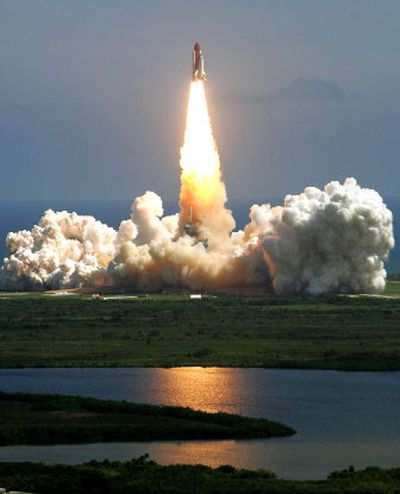Atlantis embarks on run to build up space station

CAPE CANAVERAL, Fla. – The shuttle Atlantis, America’s long-haul space truck, returned to duty Saturday, blasting into orbit with a 17-ton load of construction material for the International Space Station.
Atlantis roared off pad 39B on the last day of the launch window after two weeks of delays caused by bad weather and minor mechanical glitches.
“What we saw today was a flawless countdown and a majestic launch,” said NASA Administrator Michael Griffin.
NASA cameras captured images of five incidents of ice and insulating foam flaking off the shuttle’s external fuel tank. At least one piece of foam appeared to hit the underside of the craft.
Analysts at Johnson Space Center in Houston were studying the pictures late Saturday. But space agency officials said it was unlikely the debris could have damaged the spacecraft because the pieces were small.
The first piece of debris appeared to come off about four minutes after launch. By that time, the shuttle is 325,000 feet above Earth, where the air is too thin to accelerate debris to the speeds necessary to cause damage.
“Anything that comes off that late is of no consequence,” said N. Wayne Hale Jr., the shuttle program manager.
Hale and others stressed that the analysis of images taken by more than 100 cameras on the shuttle and at the launch site in central Florida has just begun. It will take several days to determine fully if the craft is undamaged.
The shuttle’s six-person crew is scheduled to use a boom with attached sensors today to inspect the critical leading edges of the wings, which are covered by delicate heat-resistant reinforced carbon.
Another round of inspections will be performed Monday, when Atlantis docks with the space station.
This is the third mission since NASA returned to spaceflight last year, but it will be the first mission in four years to resume work on the half-built space station.
In its payload bay, Atlantis carries a massive truss and a set of solar arrays that will double the amount of power the station produces.
When unfurled, the solar arrays will be 240 feet long. Each of the 82 array “blankets” contains 16,400 photovoltaic cells. The truss will serve as a new piece of the station’s spine, where future laboratories and crew containers will be attached.
NASA is hurrying to finish building the station before the shuttle is retired in 2010. This mission will be one of the most complicated in the history of the shuttle program, officials said.
The crew is scheduled to take three spacewalks, beginning Tuesday with the installation of the truss. Also, the solar array will be released from its housing. The work will be finished on the spacewalks Thursday and Friday.